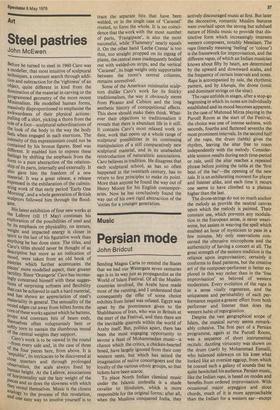Art
Steel pastries
John McEwen Before he turned to steel in 1960 Caro was a modeller, that most intuitive of sculptural techniques, a constant search through addition and subtraction for the `rightness' of an Object, quite different in kind from the domination of the material in carving or the programmed geometry of the more recent Minimalism. He modelled human forms, Massively disproportioned to emphasise the awkwardness of their physical actions : Pulling off a shirt, picking a thorn from the sole of a foot—sculptural subordinations of the look of the body to the way the body feels when engaged in such exertions. The intensity of this expressionism could not be contained by his bronze figures. Steel was different. It enabled him to express these feelings by shifting the emphasis from the form to a pure abstraction of the relationship of its parts, internally and externally. It also gave him the freedom of a new material. It was a great release, a release expressed in the exhilaration of the culminating work of that early period 'Early One Morning', and a whole generation of British sculptors followed him through the flood
gate.
His latest exhibition of four new works at the Lefevre (till 15 May) continues his exploration of the possibilities of steel and bY.its emphasis on physicality, on texture, weight and impacted energy is closer in Spirit to the last of his figurative work than anything he has done since. The titles, and Caro's titles should never be thought of as descriptive but more as an indication of mood, were taken from an old book of Pastries which further accentuates the Pieces' more modelled aspect, their greater tactility. Since 'Orangerie' Caro has increaslo. glY concerned himself with these suggestions of surprising softness and flexibility that can be achieved in such a hard material, and has shown an appreciation of steel's Materiality in general. The sensuality of the oozed edges cut away from billets forms the core of these works against which he battens, Props and contrasts bits of beam ends, tnemselves often voluptuously bent or s°ftlY torn to sustain the slumbrous mood of the central weights they support. Caro's work is to be viewed in the round ---„from every side and, in the case of three °I the four pieces here, from above. It is t!oPublic', its intricacies to be discovered at el°se quarters and through prolonged ohbservation, the scale always fixed by
man height. At the Lefevre, associations
• horizontality suit the lazy weight of the pieces and so does the slowness with which tatteY reveal themselves. Music is the closest _nalogY to the process of this revelation, dnd one easy way to involve yourself is to
trace the separate bits that have been welded, or in the single case of 'Caramel' riveted, to form the whole. It is no coincidence that the work with the most number of parts, `Frangipane', is also the most successful, while 'Flummery' nearly equals it. On the other hand `Leche Crema' is too thin, too straight propped on its zigzag of plates, the central mass inadequately bodied out with welded-on strips, and the vertical 'Caramel', its huge weight only supportable between the room's central columns, remains unresolved.
Some of the American minimalist sculptors dislike Caro's work for its finicky traditionalism, the way it obviously stems from Picasso and Cubism and the long aesthetic history of compqsitional effects. This show should make them think. Whatever their objections to traditionalism it reveals that there is abundant life in it still. It contains Caro's most relaxed work to date, work that opens up a whole range of sculptural possibilities in its continuing manipulation of a still comparatively new sculptural material, and in its unabashed reintroduction of naturalistic associations. Caro believes in tradition. He disagrees that each sculptural school, as has so often happened in the twentieth century, has to return to first principles to make its point. More than anyone he found the way out of Henry Moore for his English contemporaries. Now he has conclusively found the way out of his own rigid abstraction of the 'sixties for a younger generation.


































 Previous page
Previous page